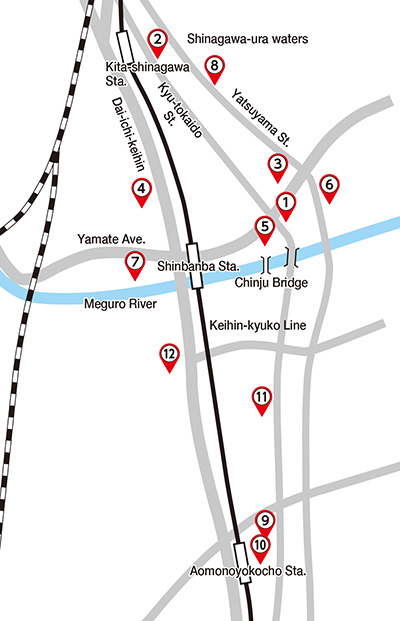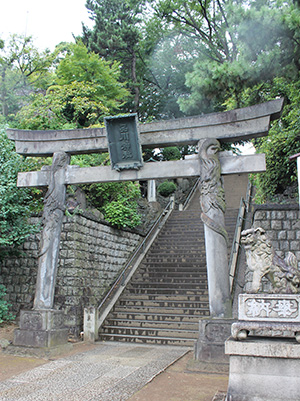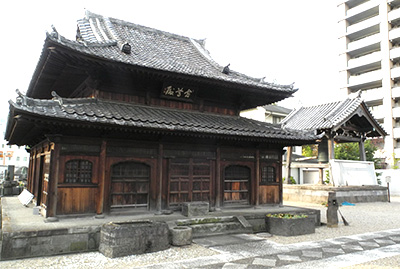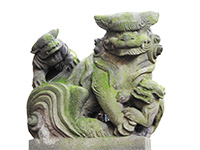
Discovering the Attractive Qualities of Shinagawa!Kyu-Tokaido area Let’s Experience History in the Kyu-Tokaido Area, Where Feudal Lords Walked! The Tokaido was an important road connecting eastern and western Japan for over a thousand years. During the Edo Period (1603–1868) there were five routes, and many shukuba (post stations) were built on those routes. On the Tokaido route from Edo (old Tokyo) to Kyoto, for example, there were 53 shukuba. Shinagawa-shuku was the first shukuba travelers reached when departing from Edo, and bustled with activity as the city’s gateway.
1: Shinagawa-shuku Koryukan(community lounge)
This information transmitting and tourist information center for Shinagawa-shuku opened in 2009. There is a free rest area on the first floor, and the second floor features an exhibition that introduces the history and culture of Shinagawa-shuku.
2: Tourist Information Center “TOIYABA”
This tourist information center for foreign tourists opened in April 2016 with English-speaking staff. They can provide directions and background on tourist spots, and offer advice on any trouble tourists might have. There are also services such as left-luggage (fees charged). The facility is a joint complex with a guesthouse.
3: Tokaido Shinagawa-shuku Honjin Site The accommodations for feudal lords and Imperial envoys were called honjin, and these facilities existed until the post station system was eliminated in 1872. The site is now a municipal park.
4: Shinagawa Shrine The most striking features of this shrine are the towering torii and Fujizuka mound seen from the entrance. Mount Fuji was an object of worship during the Edo Period, and the Fujizuka mound was built for those who could not travel to the famed mountain itself. It was said that if you climbed the mound, it was the same as climbing Mount Fuji. Fujizuka mound (Shinagawa Fuji) in this shrine was built in 1869. The Shinagawa Shrine Reitai-sai Festival (annual festival of Shinagawa Shrine) is held in June, and the mikoshi (portable shrine) makes its way up and down the 53-step stone stairs.
5: Ebara Shrine
6: Yoriki Shrine
7: Tokaiji Temple
8: Kagata Shrine and the Burial Mound of a Whale Kagata Shine, located near the harbor in Shinagawa-ura waters, is the site of a monument to a whale. In 1798 (latter Edo Period) a large whale wandered into the sea around Shinagawa due to a storm. The whale—about 16.5 meters in length and about two meters in height—becoming widely known throughout Edo. People buried its bones and built this mound as a memorial offering. This is said to be the only whale monument (whale mound) in Tokyo. 9: Honsenji Temple
10: Kaiunji Temple and the Sentaikojin Festival
11: Enmado Hall at Chotokuji Temple This temple was reportedly established in 1463 in the middle of the Muromachi Period (1336–1573). On the left side of the Main Hall within the temple grounds is the smaller Enmado Hall, where an 88-centimeter-high wooden seated statue of King Enma (King of hell) is enshrined. This statue gained popularity with the faithful during the Edo Period. It was believed that this “hell’s pot” where criminals are boiled opened on the lunar New Year and July 16, and the area drew many worshippers who came to pray to King Enma for protection.
12: Kaizoji Temple This temple was reportedly established in 1298 during the latter part of the Kamakura Period (1185–1333). During the Edo Period, it was known as “the temple of unidentified bodies,” because criminals executed at Suzugamori Execution Ground and prostitutes working at Shinagawa-shuku with no one to claim their bodies were buried there. There is a group of towers to mourn the souls of those without relatives.
|
 Copyright © 2017 Shinagawa City. All rights reserved. |












 This temple was reportedly established between 806–10 and reconstructed in 1652 during the early Edo Period. The main feature of Honsenji Temple is the statue of the jizo (Bodhisattva) built in 1708 at the entrance to its grounds, one of six jizo placed at six entrances to Edo. The figure watches over the traffic of Kyu-tokaido St. even today. The temple’s bell was lost after it was taken abroad at the end of the Edo Period, and it was found later at the Musée Ariana in Geneva, Switzerland and returned to Shinagawa.
This temple was reportedly established between 806–10 and reconstructed in 1652 during the early Edo Period. The main feature of Honsenji Temple is the statue of the jizo (Bodhisattva) built in 1708 at the entrance to its grounds, one of six jizo placed at six entrances to Edo. The figure watches over the traffic of Kyu-tokaido St. even today. The temple’s bell was lost after it was taken abroad at the end of the Edo Period, and it was found later at the Musée Ariana in Geneva, Switzerland and returned to Shinagawa.




